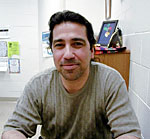By Tim Pugmire
Minnesota Public Radio
June 4, 2002
Minnesota's biggest school district is facing big problems trying to balance its budget for the coming school year. Officials in the Minneapolis school district have already cut 30-million dollars in operating expenses and recently sent layoff notices to 419 probationary teachers. School leaders say the consequences of insufficient state funding are more severe in a school district with higher concentrations of poverty and students with greater learning needs.
| |
|
|
|
||
Students from East Africa, Southeast Asia and Latin America are calling out the past tense of verbs in a classroom at the International Center for Accelerated Language Learning, also known as ICALL. The Minneapolis school district opened the center last fall as an alternative high school for older students, who are recent immigrants with limited English speaking skills.
"I want to make my English perfect, and my math, and go to college after that," says student Hared Mah, who arrived from Somalia about a year ago.
Mah is among 11,000 students receiving some form of English language instruction in Minneapolis, where total enrollment is 49,000. They speak 80 different native languages.
Driven by a wave of new immigrants, that included many Somali refugees, English language enrollment grew by 41 percent in Minneapolis since 1998.
Luis Ortega, director of English Language Learner services in the Minneapolis schools, says students arrive with widely different needs.
| |
|
|
|
||
"Some students come well-prepared in their native language with transcripts, which makes it much easier for us to know what they know, versus students who have never been in school, haven't held a pencil, and then everything in between," Ortega said.
Minneapolis spends more than $20 million a year to teach students English and get them up to speed academically. All Minnesota students, including those labeled English-language learners, are expected to pass the state reading, math and writing tests to earn a diploma. Ortega says expectations for public schools have grown since the major European immigrant waves of the last century.
"People from Europe who might have come to this country who were illiterate in their own language at the age of 17 would probably have gone to work," Oretga said. "Probably would have found a job and still be a good bread earner and sustain a family and their kids would go to school, and we had a generation to pick it up. That's not true anymore."
Minneapolis schools also have a disproportionately high number of students living in poverty. Nearly seven in 10 students fall below the income threshold for free or reduced lunch, at a cost of $10 million to the district annually. Less visible is the $1,000 Edison High School now spends from its vending machine revenue each year to provide clothing and personal items to its neediest students.
| |
|
|
|
||
School board veteran Judy Farmer say she's seen district poverty numbers nearly double during her 22 years in office. She says the result is a growing challenge for schools to help poor children succeed in the classroom.
"They can't learn if they're ill clothed, ill fed, unhealthy, hungry," Farmer said. "It's an impossible task to try to have a child sit down and learn to read if their stomach is growling and their feet are cold and their nose is running."
State lawmakers have recognized the educational needs of poor children, and they direct more than $200 million a year to individual schools. Minneapolis and St. Paul schools end up with most of the remedial education money known as compensatory revenue. The districts also fight an annual battle at the Legislature to preserve their share of the funding.
David Jennings, the district's chief operating officer, says lawmakers who criticize the cost of education in Minneapolis do not fully appreciate the extraordinary challenges of poverty. He says the district must spend money, for example, tracking down kindergarten and first grade students whose parents don't bother getting them to school.
"These kids are so resilient that by the time they're second graders they figure out how to get themselves up in the morning and get themselves dressed and get themselves to the bus stop, because they want to see their buddies and they want to have breakfast," Jennings said. "But at the kindergarten and first grade level, they're not able to do that and so they miss school."
| |
|
|
|
||
The school district hired Jennings, a former legislative leader and Minneapolis Chamber of Commerce executive, last winter to restructure a nearly $500 million operating budget. He blames the $30 million shortfall, in large part, on a drop in enrollment. This year's student count was one thousand lower than last year, and a similar decline is expected next year.
Minneapolis spends $41 million a year just on transportation. The district is required to bus its own kids, plus thousands of students who attend nonpublic schools. Desegregation efforts result in longer bus rides for many students and adds to the overall costs.
Minneapolis also has nearly 7,000 students with disabilities. Jennings, like many school administrators, is particularly concerned about the impact of the underfunding of special education. Through 30 years of regulations, the federal government has never come close to a promised 40-percent funding for special education. Jennings says the special education gap for Minneapolis this year hit $27 million.
"That means $27 million, and a growing number, that comes out of our general education revenues and other resources that should be used for more traditional classroom requirements is being siphoned off to pay for a federal requirement over which we have no control," Jennings said.
The Minneapolis school district spent nearly $11,000 on each student last year. Jennings says that cost can be attributed to the district's needs, but also to its local spending decisions. He says his job is to try to figure out how to do business more effectively, and how to make better spending decisions.
But Jennings says he's not as concerned about price as he is about graduation rates, which he admits need improvement. The latest state completion study found just 47 percent of Minneapolis 9th-grade students graduate from high school within four years.
School district officials say they're committed to improving graduation rates and test scores in spite of the challenges. They're spending millions each year to help raise student achievement.
School board member Judy Farmer says public schools in Minneapolis and elsewhere are not the failures some people claim them to be. She says schools need public support, not criticism.
"I think they are struggling to deliver what the community wants and those expectations keep increasing and the funds don't," Farmer said. "I think we're sort of on a collision course between our expectations and our willingness to support the things we say we believe in."
The Minneapolis school board will take final action on a trimmed down 2002-2003 operating budget later this month.




